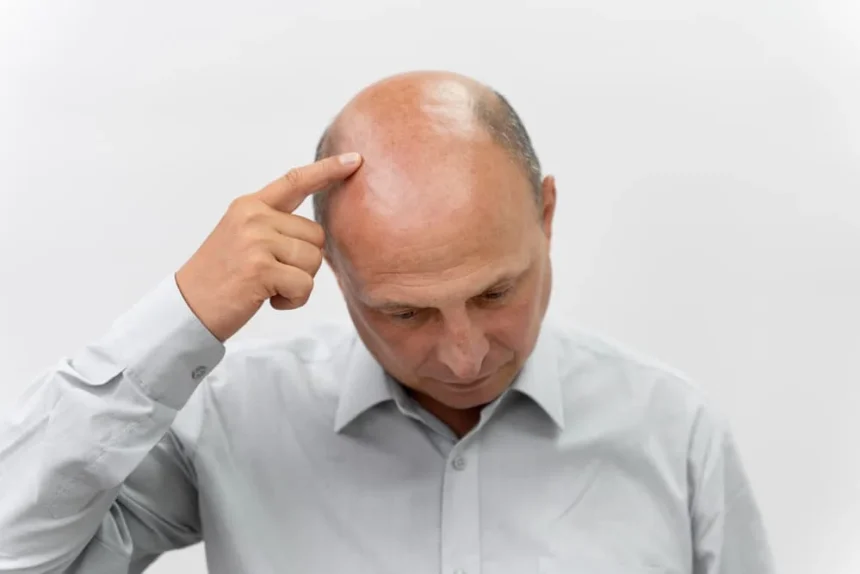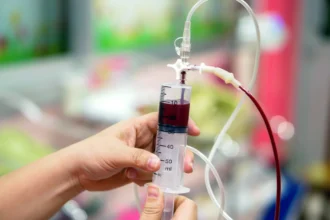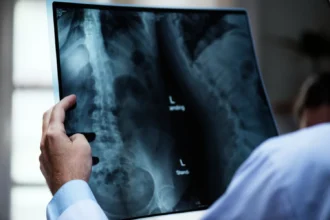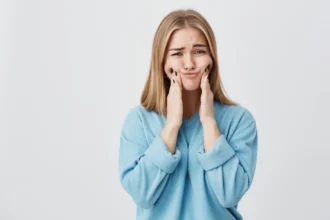Noticing your hair thinning? You’re not alone. Researches shows that 40% of men experience some degree of male pattern hair loss by age 35, and this number rises to 65% by age 50. While genetics play a major role, factors like stress, poor nutrition, and lifestyle choices can speed up the process.
But does hair loss mean there’s nothing you can do? Absolutely not! Today, various treatments can slow, stop, and even reverse hair loss in some cases. Understanding the causes and available solutions is the first step toward maintaining a fuller head of hair.
What Is Male Pattern Hair Loss?
Also known as androgenetic alopecia, this is the most common type of hair loss in men. It occurs due to a combination of genetics and the hormone dihydrotestosterone (DHT). DHT is a byproduct of testosterone that gradually shrinks hair follicles, leading to thinner, weaker hair that eventually stops growing.
Signs of male pattern baldness often start with:
✔ A receding hairline—typically forming an “M” shape.
✔ Thinning at the crown, which may expand over time.
✔ Increased hair shedding, especially during washing or brushing.
Over time, these areas may merge, leading to more noticeable baldness.
How Common Is?
Male pattern baldness is incredibly common and tends to progress with age:
✔ By age 25 → 25% of men experience noticeable hair thinning.
✔ By age 35 → Around 40% have some degree of hair loss.
✔ By age 50 → Nearly 65% show significant balding.
If you’re noticing early signs, you’re far from alone—and the good news is that there are effective ways to manage and slow it down.
Stages of Male Pattern Hair Loss
Male pattern baldness progresses gradually and typically follows a predictable pattern. The first noticeable sign is often a receding hairline, starting at the temples and forming an “M” shape. Over time, thinning at the crown develops, and as both areas expand, they may eventually merge—leading to more extensive hair loss.
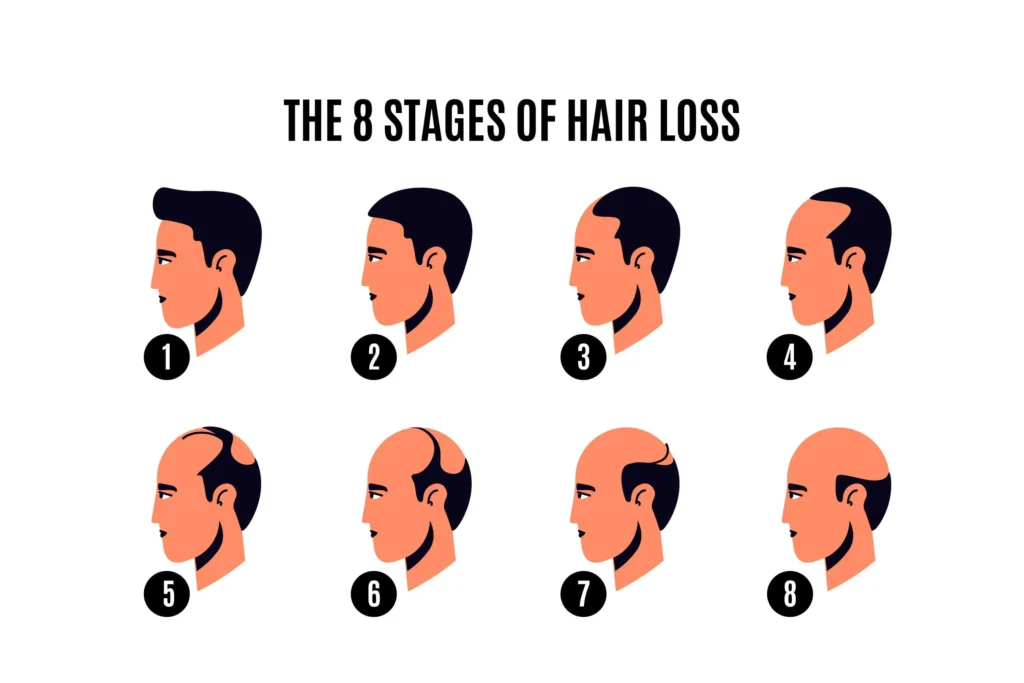
The Norwood Scale is the most widely used classification system for tracking hair loss progression, dividing it into seven stages:
✔ Stage 1: No visible hair loss.
✔ Stage 2: Slight recession of the hairline.
✔ Stage 3: Noticeable receding hairline, often forming an “M” shape.
✔ Stage 4: Thinning at both the hairline and crown.
✔ Stage 5: More pronounced baldness at the front and crown.
✔ Stage 6: The hairline is nearly gone, and the crown is significantly bald.
✔ Stage 7: Only a horseshoe-shaped ring of hair remains at the back and sides.
Why It Matters: Recognizing early signs allows you to seek treatment before hair loss becomes severe. The sooner you take action, the better your chances of slowing the process.
Causes of Male Pattern Hair Loss
Androgenetic alopecia is influenced by a mix of genetics, hormones, and lifestyle factors.
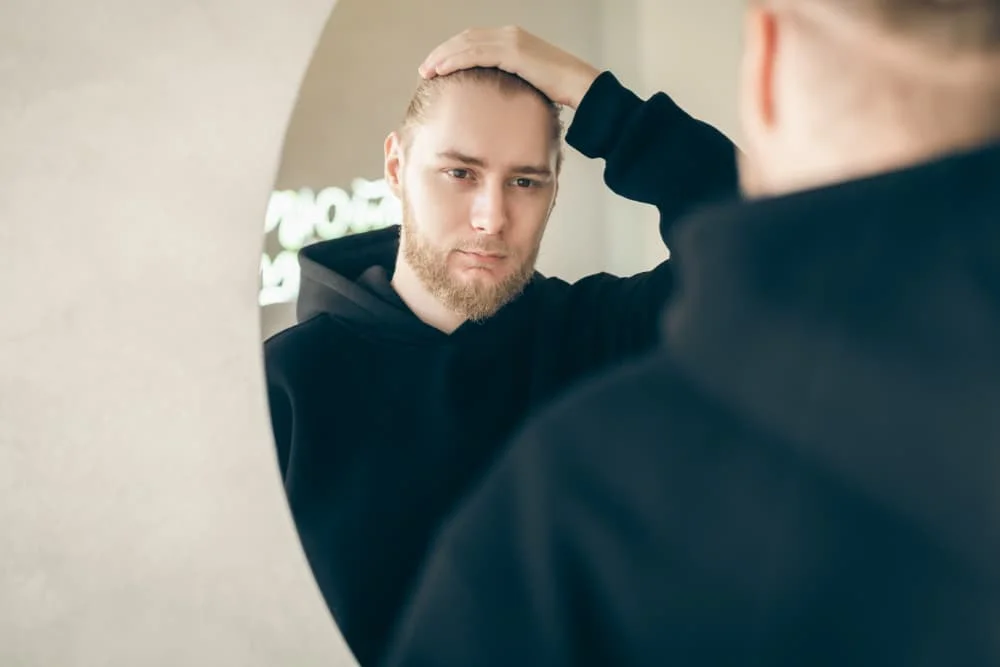
1. Genetic Predisposition
The most significant factor in male pattern baldness is family history. If close relatives—on either side of your family—have experienced hair loss, your risk is higher. Genetics determine how sensitive your hair follicles are to DHT, the hormone responsible for shrinking follicles and causing hair to thin over time.
2. Hormonal Influence: The Role of DHT
Dihydrotestosterone (DHT) is a byproduct of testosterone and plays a crucial role in hair loss.
🔹 How DHT Affects Hair: It binds to hair follicles, causing them to shrink (miniaturization), leading to thinner, weaker hair.
🔹 The Result: Shorter growth cycles, slower regrowth, and eventually, follicles stop producing hair altogether.
3. Lifestyle and Environmental Factors
Beyond genetics and hormones, certain lifestyle habits can accelerate hair thinning:
✔ Chronic Stress: Increases cortisol levels, disrupting the hair growth cycle.
✔ Nutrient Deficiency: Diets low in zinc, iron, biotin, and vitamin D weaken hair.
✔ Unhealthy Habits: Smoking, poor sleep, and a sedentary lifestyle worsen hair loss over time.
The Good News? Identifying contributing factors early can help you take preventive steps to slow hair loss and protect existing hair.
Do Bald Men Have Higher Testosterone? (Myth vs. Reality)
🚫 Myth: Bald men have more testosterone.
✅ Truth: Hair loss is not caused by higher testosterone levels but rather by how sensitive hair follicles are to DHT.
Having higher testosterone does not automatically mean you’ll go bald. Instead, the way your body processes and reacts to DHT determines whether hair loss will occur.
Can Male Pattern Hair Loss Be Treated?
A common question many men ask is: Can lost hair grow back? The answer depends on several factors, including the stage of hair loss, the health of hair follicles, and the treatment method used.
While fully restoring hair in bald areas isn’t always possible, several treatments can help preserve existing hair, slow further loss, and even stimulate new growth in some cases.
Treatment Options for Male Pattern Baldness
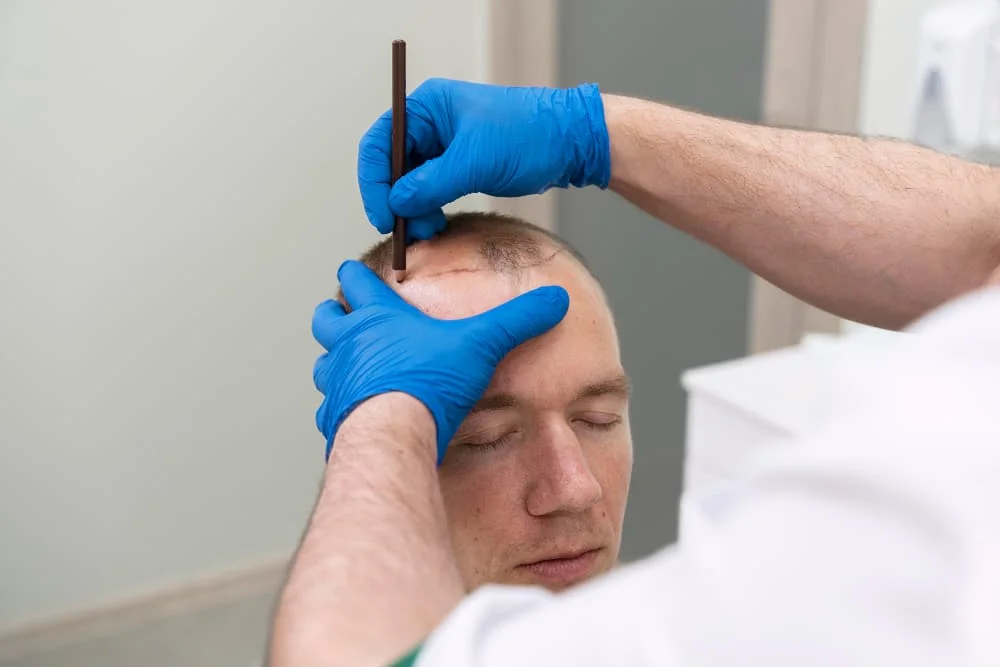
1. Medications
✔ Minoxidil (Topical Solution): Applied directly to the scalp, minoxidil stimulates hair follicles and may encourage regrowth. Consistency is key—visible results typically appear after 3–6 months.
✔ Finasteride (Oral Medication): A DHT-blocking medication that slows hair loss and may promote new growth in some men. It requires daily use and works best in the early stages of hair loss.
2. Hair Transplant Surgery
For long-term results, hair transplant procedures involve moving healthy hair follicles from the back or sides of the head to thinning areas. Two common techniques include:
✔ FUE (Follicular Unit Extraction): Individual follicles are extracted and implanted.
✔ DHI (Direct Hair Implantation): A more precise method, where follicles are implanted directly without prior incisions.
Hair transplants provide natural-looking, permanent results but require a healing period and multiple sessions for optimal coverage.
3. Alternative Treatments
For those seeking non-surgical options, these treatments may help:
✔ PRP (Platelet-Rich Plasma): Injecting your own platelet-rich plasma into the scalp to stimulate follicles and improve hair health.
✔ Mesotherapy: A combination of vitamins, minerals, and amino acids injected into the scalp to support growth.
✔ Low-Level Laser Therapy (LLLT): Uses red light lasers to stimulate hair follicles and improve thickness over time.
Choosing the Right Hair Loss Treatment
Not all treatments work the same for everyone. The best approach depends on:
🔹 The stage of your hair loss
🔹 The condition of your hair follicles
🔹 Your age and overall health
🔹 Your personal goals and expectations
While some treatments can slow or halt hair loss, regrowing completely lost hair is rare. Consulting a doctor or hair specialist ensures you choose the most effective approach for your situation.
What Helps Male Pattern Hair Loss? (Natural Remedies)
If you’re looking for home remedies to support hair health, some natural ingredients may help strengthen hair, improve scalp health, and reduce shedding. Here are some options:

1. Rosemary Oil
✔ Benefits: Boosts blood circulation in the scalp and may reduce DHT’s effect on hair follicles.
✔ How to Use: Mix a few drops with carrier oil (like coconut oil) and massage into the scalp 2-3 times per week.
2. Saw Palmetto
✔ Benefits: Known for its DHT-blocking properties, helping to slow hair loss.
✔ How to Use: Take saw palmetto supplements or use hair products containing saw palmetto extract.
3. Coconut Oil
✔ Benefits: Moisturizes the scalp, prevents breakage, and nourishes hair.
✔ How to Use: Massage into the scalp, leave for 30 minutes, then rinse.
4. Aloe Vera
✔ Benefits: Soothes the scalp, reduces inflammation, and supports growth.
✔ How to Use: Apply fresh aloe vera gel to the scalp, wait 20–30 minutes, then rinse.
5. Onion Juice
✔ Benefits: Contains sulfur compounds that improve circulation and may stimulate hair regrowth.
✔ How to Use: Apply fresh onion juice to the scalp for 15–20 minutes, then wash thoroughly.
6. Green Tea Rinse
✔ Benefits: Packed with antioxidants that protect follicles from damage.
✔ How to Use: Brew strong green tea, let it cool, and rinse your scalp with it for 10–15 minutes before washing.
⚠ Note: While natural remedies can support hair health, they won’t reverse advanced hair loss. If hair thinning continues, consult a doctor or dermatologist for professional advice.
How to Prevent Male Pattern Hair Loss
While genetics play a major role in hair loss, certain lifestyle habits and preventive measures can slow the process and help maintain hair health for as long as possible.
1. Focus on a Hair-Healthy Diet
Your hair needs essential nutrients to stay strong and prevent thinning. Include:
✔ Biotin – Supports keratin production (Eggs, almonds, avocados)
✔ Iron & Zinc – Strengthen follicles and promote growth (Red meat, spinach, pumpkin seeds)
✔ Protein – Builds strong hair strands (Fish, legumes, dairy)
✔ Omega-3 Fatty Acids – Nourish the scalp and reduce inflammation (Salmon, walnuts, flaxseeds)
2. Choose the Right Hair Care Routine
The way you care for your hair impacts its strength and longevity. Adopt these best practices:
✔ Use Gentle, Chemical-Free Products – Choose sulfate-free and paraben-free shampoos to protect hair.
✔ Try DHT-Blocking Shampoos – Special formulas reduce DHT’s effect on hair follicles.
✔ Wash Hair Gently – Avoid hot water and aggressive towel drying to prevent breakage.
3. Manage Stress Levels
Stress is a major contributor to hair loss. Implement stress-reducing habits:
✔ Meditation & Yoga – Helps regulate cortisol levels, reducing hair shedding.
✔ Deep Breathing Exercises – Aids relaxation and improves circulation to the scalp.
✔ Regular Exercise – Supports overall well-being and increases blood flow to hair follicles.
4. Maintain a Healthy Lifestyle
Some habits worsen hair thinning. Here’s what to avoid:
✔ Quit Smoking – Smoking reduces blood circulation to hair follicles, leading to hair loss.
✔ Limit Alcohol Intake – Excessive alcohol can negatively affect nutrient absorption and hair health.
✔ Prioritize Quality Sleep – 7-8 hours of good sleep is essential for cell renewal and follicle repair.
Can You Completely Prevent Male Pattern Baldness?
While genetics largely determine hair loss, early intervention and lifestyle changes can slow the process and preserve existing hair. Adopting healthy habits, using targeted treatments, and seeking expert guidance can make a real difference in fighting male pattern baldness.

